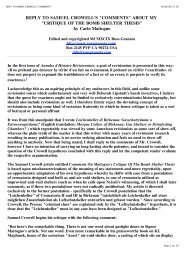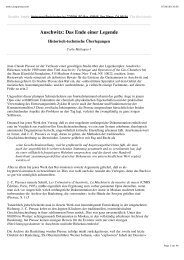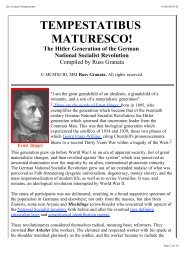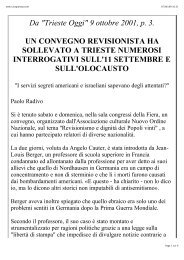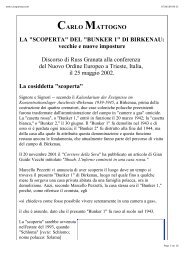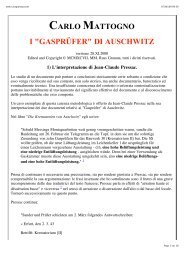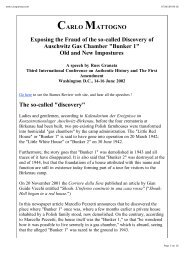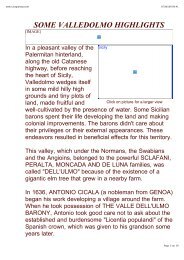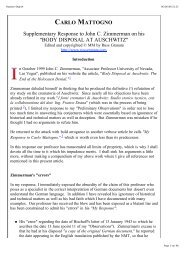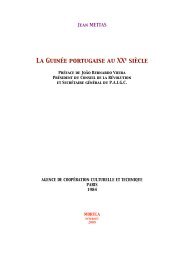AUSCHWITZ 1270 TO THE PRESENT - morula
AUSCHWITZ 1270 TO THE PRESENT - morula
AUSCHWITZ 1270 TO THE PRESENT - morula
Create successful ePaper yourself
Turn your PDF publications into a flip-book with our unique Google optimized e-Paper software.
<strong>AUSCHWITZ</strong> <strong>1270</strong> <strong>TO</strong> <strong>THE</strong> <strong>PRESENT</strong><br />
06/06/09 08:23<br />
"<strong>AUSCHWITZ</strong> <strong>1270</strong> <strong>TO</strong> <strong>THE</strong> <strong>PRESENT</strong>"<br />
Note critiche di Carlo Mattogno<br />
Debórah Dwork e Robert Jan van Pelt sono gli autori di un voluminoso libro, apparso nel<br />
1996, dal titolo Auschwitz <strong>1270</strong> to the present (1) . La seconda parte dell'opera è dedicata alla<br />
storia del campo di Auschwitz, ma presenta poco o nulla di originale, costituendo un<br />
semplice ampliamento dell'articolo di Robert Jan van Pelt A Site in Search of a Mission (2) .<br />
Il volume è riccamente illustrato e reca un inserto di 24 pagine non numerate in carta lucida<br />
intitolato Plates. Blueprints of Genocide, in cui sono riprodotte 20 piante (3) , ma i suoi pregi<br />
si esauriscono qui. I difetti, invece, sono molti e gravi.<br />
I) La metodologia<br />
1)Anzitutto, la metodologia adottata dagli autori è scientificamente carente. Essi si<br />
richiamano ad una sorta di procedimento induttivo che vuole risalire dal documento - i<br />
disegni della Zentralbauleitung - all'intenzione che lo ha animato:<br />
"Every decision Himmler took with regard to Auschwitz, or Höss took about the camp<br />
over which he reigned, had implications for the physical site. If prisoners were to be<br />
shipped in, barracks were needed; if the deportees' goods were to be claimed for the<br />
Reich, storehouses were required. If masses of people were to be murdered, incinerators<br />
to burn their bodies were essential. The documents of the Building Office archive<br />
retrace the course in reverse from the structure back to the decision, the thinking, the<br />
idea. These materials illuminate the possibilities the Germans considered and the<br />
options they chose, their ambition as well as its outcome" (4) .<br />
Tuttavia questo procedimento è inficiato già in partenza dal fatto che esso non si basa quasi<br />
mai su documenti scritti, ma quasi sempre su testimonianze. Gli autori manifestano una<br />
ignoranza pressoché totale dell'organizzazione e dei compiti della Zentralbauleitung di<br />
Auschwitz, nonché delle procedure tecniche e amministrative che regolavano la costruzione<br />
dei vari Bauvorhaben, Bauwerke e Bauabschnitte di sua competenza (5) . Da ciò non possono<br />
scaturire che gravi errori e fraintendimenti. Gli autori mostrano inoltre una straordinaria<br />
ignoranza della enorme mole di documenti della Zentralbauleitung che riguardano<br />
specificamente la progettazione e la costruzione del campo. I documenti di questo tipo da<br />
essi menzionati sono pochi e male interpretati. Non stupisce dunque che i risultati dei loro<br />
procedimenti induttivi siano elucubrazioni fallaci che non trovano alcun riscontro nella realtà.<br />
Un altro rimprovero che bisogna muovere agli autori è la loro sfrontata assunzione di tesi<br />
elaborate da Jean-Claude Pressac senza il minimo riferimento alla fonte, come se si trattasse<br />
di loro scoperte; in tutto il libro, lo studioso francese è nominato una volta sola! Rispetto<br />
all'ultimo libro di Jean-Claude Pressac (6) , che pure costituisce un notevole regresso rispetto<br />
Page 1 sur 22
<strong>AUSCHWITZ</strong> <strong>1270</strong> <strong>TO</strong> <strong>THE</strong> <strong>PRESENT</strong><br />
06/06/09 08:23<br />
all'opera precedente (7) , Auschwitz <strong>1270</strong> to the present rappresenta una pesante ricaduta in<br />
quella storiografia aberrante giustamente da lui stigmatizzata come<br />
"based for the most part on testimonies, assembled according to the mood of the<br />
moment, truncated to fit an arbitrary truth and sprinkled with a few German documents<br />
of uneven value and without any connection with one another" (8) .<br />
E in effetti gli autori confessano candidamente:<br />
"Our first and greatest debt is to the survivors, whose oral histories were a vital source<br />
of information" (p.379).<br />
Ciò è vero alla lettera: gli autori "dimostrano" infatti la realtà del presunto sterminio in massa<br />
ad Auschwitz ricorrendo esclusivamente alle testimonianze, con l'assiduo ausilio del<br />
Kalendarium di Auschwitz, sicché essi offrono un semplice riassunto di ciò che era già noto,<br />
ma con un nuovo inquadramento storico e con molti spropositi supplementari. In ciò che<br />
segue, espongo alcuni tra quelli più grossolani, che mostrano ad abundantiam<br />
l'incompetenza, la mancanza di senso critico e anche la maladefe dei due autori.<br />
II) Progettazione, finanziamenti, costruzione del campo<br />
2) Secondo i due autori, la pianta del KGL del 7 ottobre 1941 prevedeva l'alloggiamento di<br />
97.000 detenuti.<br />
"This plan was modified at a mid-October meeting, and the second version became the<br />
basis for the fourteen-page accompanying document explaining the design. The single<br />
most important change was an expansion of the camp's capacity from 97,000 to<br />
125,000 inmates. One drawning, illustrating a section of the standard hut to be built,<br />
makes it absolutely clear that this increase was achieved simply by cramming more<br />
inmates into the same space. The original drawning, signed by Bischoff on 8 October,<br />
listed a capacity of 550 men. A while later Bischoff crossed out "550" and replaced it<br />
with "744". Nothing else had changed " (p.263).<br />
La ragione di questo cambiamento addotta dagli autori è sorprendente:<br />
"Perhaps Bischoff's decision was inspired by the arrival of the first prisoners of war.<br />
Like so many other Germans, he perceived the starved, ill, and emaciated men as<br />
subhumans entitled to even less living space than he originally had allotted them"<br />
(p.263).<br />
Page 2 sur 22
<strong>AUSCHWITZ</strong> <strong>1270</strong> <strong>TO</strong> <strong>THE</strong> <strong>PRESENT</strong><br />
06/06/09 08:23<br />
Ancora più esplicitamente i due autori affermano:<br />
"The designs illustrate the ideology reflected in Bischoff's stroke of the pen through the<br />
number 550 and insertion of 744. The German identification of the Soviet soldier as an<br />
Untermensch was translated into architectural terms" (p.265).<br />
In realtà nelle due piante summenzionate non appare alcuna indicazione riguardo alla loro<br />
capacità e non esiste alcun documento da cui risulti che per il KGL fosse prevista<br />
inizialmente una capacità di 97.000 detenuti. L'ordine di costruzione del KGL, impartito dall'<br />
SS-Oberführer Kammler - allora capo dell' Amt II dello Hauptamt Haushalt und Bauten - con<br />
effetto retroattivo il 1° novembre 1941, diceva esplicitamente:<br />
"Der Baubefehl für die Errichtung eines Kriegsgefangenenlagers in Auschwitz zur<br />
Unterbringung von 125.000 Kriegsgefangenen wird hiermit erteilt" (9) .<br />
Dunque l'aumento di forza menzionato dagli autori è pura fantasia. Contrariamente a ciò che<br />
essi sostengono, la pianta del KGL del 15 ottobre 1941 presenta almeno due rilevanti<br />
differenze che giustificano la necessità del nuovo disegno: il settore "Unterkünfte für<br />
Wachtruppe" inserito a est della futura Bauabschnitt III e l'eliminazione del<br />
"Kommandanturgebäude" prima collocato all' ingresso al campo (10) . Non c'è dubbio che la<br />
pianta di una "Unterkunftbaracke für ein Gefangenenlager" prevedesse una capacità di 550<br />
uomini e che questa cifra sia stata camcellata a matita e sostituita con 744, tuttavia si ignora<br />
quando e perché sia stata apportata questa modifica e comunque essa non ha alcuna relazione<br />
con la capacità totale del campo. Resta infine da stabilire da dove gli autori abbiano tratto la<br />
capacità di 97.000 prigionieri. Nell'inserto "Blueprints of Genocide" i due autori<br />
commentano così la pianta del KGL del 7 ottobre 1941:<br />
"To the left is the quarantine camp for 17,000 men. Built as drawn, it became the<br />
women's camp in late 1942. To the right, centered on an enormous Appelplatz (roll call<br />
place), is the camp proper, designed to hold 80,000 men".<br />
Come ho già rilevato, queste cifre non si trovano sulla pianta ed è chiaro che gli autori le<br />
hanno ricavate semplicemente moltiplicato il numero degli "Unterkunftsgebäude" per la<br />
capacità di una "Unterkunftbaracke" e arrotondando i risultati, cioè:<br />
(30 x 550) = 16.500, arrotondato dagli autori a 17.000; (144 x 550) = 79.200,<br />
arrotondato dagli autori a 80.000; (17.000 + 80.000) = 97.000!<br />
Page 3 sur 22
<strong>AUSCHWITZ</strong> <strong>1270</strong> <strong>TO</strong> <strong>THE</strong> <strong>PRESENT</strong><br />
06/06/09 08:23<br />
3) Riguardo al preventivo di costo iniziale del KGL, gli autori scrivono che "the total budget<br />
was to be 8.9 milion marks" (p.264) e aggiungono:<br />
"The SS head office reduced the total cost from 8.9 million marks to 7.7 million, as the<br />
standard rate for labor costs did not apply, the prisoners were to build the camp<br />
themselves, free of charge" (p.265).<br />
Questa affermazione è il risultato di una grossolana incomprensione degli autori. Il<br />
"Kostenvoranschlag für den Vorentwurf über den Neubau des Kriegsgefangenenlagers der<br />
Waffen-SS Auschwitz O./S." redatto il 30 ottobre 1941 prevedeva un costo totale di 8.900.000<br />
RM. (11) . Dopo l'esame tecnico-specialistico dell'organo competente (12) , questa somma fu<br />
abbassata a 8.553.700 RM, da cui fu defalcato il 10% "für Häflingsarbeit", arrotondato a<br />
853.700 RM, perciò la somma finale prevista fu di 7.700.000 RM (13) .<br />
4) I due autori rilevano poi quanto segue:<br />
"Bischoff arrived in Auschwitz on 1 October. Within a few weeks he had compiled a<br />
budget: he would need 13,6 million marks for the first phase of the project, and another<br />
7 million to complete building the whole camp. Significantly, the budget stated that 'a<br />
license number will be given by the chemical industry through IG Farben', which meant<br />
that the camp would receive material allocations from the resources at the disposal of<br />
Krauch, the plenipotentiary general for special questions of chemical production.<br />
Kammler approved the budget and forwarwed a copy to Krauch, who was taken aback<br />
by the proposal. [...]<br />
In response to IG Farben's unwillingness to support a 20,6 million operation, Bischoff<br />
proposed two plans. The first, budgeted at 2.02 million marks, was called "Provisional<br />
Expansion of the Concentration Camp Auschwitz O/S [Oberschlesien, or Upper<br />
Silesia]," which was to be built with construction material supplied through IG Farben.<br />
Its main purpose was to demonstrate responsability to the corporation. The second plan,<br />
"Building Project Auschwitz", budgeted at 20.6 million marks, was Bischoff's real<br />
agenda" (pp.214-218).<br />
Qui i due autori prendono un abbaglio madornale.<br />
Secondo le disposizioni di Speer come Generalbevollmächtigte für die Regelung der<br />
Bauwirtschaft (in forma abbreviata: G.B.-Bau), la realizzazione di un Bauvorhaben<br />
richiedeva, come atto amministrativo preliminare, la sua classificazione (Einstufung) nelle<br />
liste dell'ordine di precedenza del distretto di appartenenza (Wehrkreisrangfolgelisten). Al<br />
momento dell'inserimento in tali liste, il Bauvorhaben riceveva un numero di riconoscimento<br />
(G.B.-Bau Kennnummer) che rappresentava, per così dire, il suo atto di nascita<br />
Page 4 sur 22
<strong>AUSCHWITZ</strong> <strong>1270</strong> <strong>TO</strong> <strong>THE</strong> <strong>PRESENT</strong><br />
06/06/09 08:23<br />
amministrativo e avviava tutte le procedure necessarie per la costruzione, a cominciare<br />
dall'assegnazione dei materiali edilizi. Per gli impianti chimici la procedura era la stessa, ma<br />
essi dipendevano dal Generalbevollmächtigte für Sonderfragen der Chemischen Erzeugung<br />
Carl Krauch.<br />
Il Bauvorhaben del futuro campo di Monowitz apparteneva al complesso chimico IG Farben<br />
e ricevette perciò il Bau-Kennnummer "0. Wo-E (Chem) Katt. 3009". A ciò si riferisce il<br />
"license number" menzionato da Dwork e van Pelt. Secondo la lettera di Bischoff al WVHA<br />
del 17 marzo 1942 per il Bauvorhaben suddetto erano stati preventivati 4.660.000 RM, per i<br />
restanti Bauvorhaben dipendenti da Speer 19.594.300 RM così ripartiti:<br />
SS-Unterkunft und K.L. Auschwitz: 7.057.400 RM<br />
Kriegsgefangenenlager der Waffen-SS: 9.663.900 RM<br />
Landwirtschaftliche Bauten: 2.442.000 RM<br />
Sonstiges: 193.000 RM<br />
Hauptwirtschaftslager der Waffen-SS: 238.000 RM (14) .<br />
E' dunque insensato affermare che i Bauvorhaben dipendenti da Speer dovessero " receive<br />
material allocations from the resources at the disposal of Krauch" e che la IG Farben li<br />
dovesse finanziare.<br />
5) Nell'interpretazione dei due "plans" di Bischoff, gli autori danno un altro saggio di<br />
straordinaria ignoranza. In effetti, l' Erläuterungsbericht zum prov. Ausbau des<br />
Konzentrationslager Auschwitz O/S del 15 luglio 1942, con un preventivo di 2.026.000 RM,<br />
non ha nulla a che fare con la IG Farben, ma si riferisce semplicemente ai lavori relativi al<br />
campo di Auschwitz eseguiti nel primo e secondo anno finanziario di guerra, come viene<br />
spiegato chiaramente a pagina 9 del documento (15) ; l' Erläuterungsbericht zum Bauvorhaben<br />
Konzentrationslager Auschwitz O/S, parimenti datato 15 luglio 1942, si riferisce invece ai<br />
lavori da eseguire nel terzo anno finanziario di guerra, come si legge a pagina 19 del<br />
documento (16) .<br />
6) I due autori affermano inoltre che i presunti Bunker omicidi "physically, were located<br />
outside Birkenau" ma "administratively, belonged to the main camp" (p.321).<br />
Ma allora perché di questi Bunker non appare alcuna traccia né nell' Erläuterungsbericht<br />
zum prov. Ausbau des Konzentrationslager Auschwitz O/S né nell' Erläuterungsbericht zum<br />
Bauvorhaben Konzentrationslager Auschwitz O/S, che sono entrambi datati 15 luglio 1942<br />
(periodo in cui i due presunti Bunker omicidi erano già operativi) e che si riferiscono<br />
entrambi "administratively" al "main camp" di Auschwitz?<br />
I due autori non si pongono neppure la domanda.<br />
III) Deduzioni fantasiose<br />
Page 5 sur 22
<strong>AUSCHWITZ</strong> <strong>1270</strong> <strong>TO</strong> <strong>THE</strong> <strong>PRESENT</strong><br />
06/06/09 08:23<br />
I due esempi che seguono mostrano in modo particolare con quanta sfrenata fantasia<br />
D.Dwork e R.J. van Pelt interpretino i documenti.<br />
7) Nel rapporto annuale per il 1941 redatto da Kammler in qualità di capo dell' Amt II -<br />
Bauten dell' Hauptamt Haushalt und Bauten, D. Dwork e R.J. van Pelt hanno trovato la<br />
seguente frase:<br />
"Model designs have been drawn for permanent and provisional delousing installations<br />
for the Waffen SS, the police, and concentration camps, and for provisional and<br />
permanent crematoria, incinerating sites, and execution grounds of various kinds"<br />
(p.218).<br />
Il testo tedesco dice:<br />
"Für Entlausungsanstalten der Waffen-SS, Polizei und KL in fester und behelfsmässiger<br />
Bauweise wurden Richtzeichnungen bearbeitet, desgleichen für die behelfsmässigen<br />
und festen Krematorien, Verbrennungsstätten und Exekutionsanlagen verschiedener<br />
Art" (17) .<br />
Poi i due autori pongono questo documento nel contesto della presunta convocazione di Höss<br />
a Berlino da parte di Himmler (p.280) e, attraverso il noto passo del Mein Kampf in cui<br />
Hitler auspica che "at the beginning of the War and during the War twelwe or fifteen<br />
thousand of these Hebrew corrupters of the people had been held under poison gas" (p.281),<br />
giungono a questa sorprendente conclusione:<br />
"Himmler's instruction to Höss was, we believe, a result of Hitler's instruction to<br />
Himmler. Hitler had made it clear that, if revolution was attempted during this war as it<br />
had been at the close of the last war, the participants and the camp inmates were to be<br />
killed in extermination installations in the concentration camps" (p.282).<br />
Incredibilmente, dal semplice termine "Exekutionsanlagen" (per di più mal tradotto con<br />
"execution grounds"), i due autori desumono un piano di uccisione di tutti i detenuti dei<br />
campi di concentramento!<br />
8)D. Dwork e R.J. van Pelt scrivono ancora:<br />
"Eichmann telephoned Kammler to ask him when the crematoria would be ready.<br />
Informed only by Bischoff, who was loath to admit that construction had fallen two<br />
months behind schedule, Kammler reported the current official prognosis: crematorium<br />
Page 6 sur 22
<strong>AUSCHWITZ</strong> <strong>1270</strong> <strong>TO</strong> <strong>THE</strong> <strong>PRESENT</strong><br />
06/06/09 08:23<br />
II would be operational on 31 January, crematorium IV on 28 February, and<br />
crematorium III on 31 March" (p.329).<br />
La telefonata di Eichmann non è attestata da alcun documento ed è una semplice invenzione<br />
dei due autori, i quali, per completare l'inganno, lasciano intendere che "Kammler reported" i<br />
dati summenzionati ad Eichmann, il che è un'altra invenzione. Il documento al quale gli<br />
autori si riferiscono è la lettera di Bischoff a Kammler del 18 dicembre 1942 (18) , dalla quale<br />
soltanto con una fantasia prodigiosa si possono dedurre le invenzioni dei due autori.<br />
IV) La presunta visita di Himmler ad Auschwitz nel 1943<br />
9) D. Dwork e R.J. van Pelt dichiarano:<br />
"Crematorium III was transferred to the camp authorities on 24 June [1943], after<br />
Salonika had become Jew free. The camp now had an official daily incineration<br />
capacity of 4,756 corpses and, according to Vrba and Höss's aide Franz Hössler,<br />
Himmler came to see what he had wrought. All four crematoria in Birkenau had been<br />
completed, but the precise date is unknown. Höss himself never mentioned this visit.<br />
Himmler arrived at Auschwitz at eight o'clock and was expected to attend a gassing<br />
after breakfast at nine, Vrba has reported".<br />
Seguono altre tredici righe nelle quali i due autori descrivono la presunta gasazione basandosi<br />
sulla testimonianza di Rudolf Vrba (pp.332-333).<br />
Il riferimento a Franz Hössler è tratta dalKalendarium di Auschwitz di Danuta Czech (nota<br />
64 a p.418). In quest'opera, nella nota introduttiva all'anno 1943, D.Czech scrive:<br />
"Die Gründe für diese Dreiteilung teilt der Reichsführer SS Höss persönlich mit,<br />
höchstwahrscheinlich während seines dritten Besuchs in Auschwitz im Sommer 1943,<br />
den Höss wegen der für ihn unangenehmen Folgen nicht mehr erinnert bzw. in seiner<br />
Autobiographie nicht erwähnt. Wie Franz Hössler, in seiner Aussage während des<br />
Bergen-Belsen-Prozesses, mitteilt, hat Himmler während seines Besuchs im Sommer<br />
1943 das Lager Birkenau besucht" (19) .<br />
Al processo Belsen, l'ex SS-Obersturmführer Franz Hössler dichiarò:<br />
"Whilst I was there the place was inspected by Obergruppenführer Glücks from Berlin<br />
in summer, 1943. [...]. The camp at Birkenau was also inspected by Himmler whilst I<br />
was there in summer, 1943, who said the same - that conditions would be altered - but<br />
again nothing was done" (20) .<br />
Page 7 sur 22
<strong>AUSCHWITZ</strong> <strong>1270</strong> <strong>TO</strong> <strong>THE</strong> <strong>PRESENT</strong><br />
06/06/09 08:23<br />
Quanto sia attendibile questa affermazione risulta dal fatto che Hössler vi confonde Pohl con<br />
Glücks. In effetti, l' SS-Brigadeführer Glücks visitò Auschwitz nell'inverno 1943 non<br />
nell'estate (precisamente, il 7 gennaio) (21) . Nell'estate 1943 - il 17 settembre - ci fu invece la<br />
visita dell' SS-Obergruppenführer Pohl (22) .<br />
Le due visite di Himmler ad Auschwitz, il 1° marzo 1941 e il 17 e 18 luglio 1942, sono<br />
ineccepibilmente attestate da documenti. La presunta terza visita, invece, è talmente<br />
evanescente che se ne ignora persino il mese preciso! D. Czech, nel passo citato sopra, si<br />
accontenta di menzionare l' "estate 1943", tuttavia nelle registrazioni cronologiche relative al<br />
1943 la visita di Himmler non è indicata affatto. D.Czech non avrebbe saputo in quale data<br />
collocarla! Rudolf Höss, infine, su tale questione è categorico:<br />
"Die nächste Begegnung war im Sommer 1942 als Himmler zum zweiten und letzten<br />
Mal Auschwitz besuchte" (23) .<br />
E' dunque chiaro che la visita di Himmler ad Auschwitz del 1943 non ha alcun fondamento<br />
storico, e questo è un esempio della superficialità di D.Czech.<br />
D. Dwork e R.J. van Pelt fanno ancora di peggio: non solo accettano questa storia infondata,<br />
dando prova di scarsissimo senso critico, ma tentano perfino di avallarla con un<br />
procedimento apertamente capzioso.<br />
Essi infatti menzionano insieme Vrba e Hössler come se i due testimoni si confermassero a<br />
vicenda. In realtà, mentre Hössler, come si è visto, pone la presunta visita di Himmler ad<br />
Auschwitz nell'estate 1943, Vrba la colloca nel gennaio 1943. Egli scrive:<br />
"Heinrich Himmler visited Auschwitz Camp again in January, 1943" (24) .<br />
E la presunta gasazione omicida che R. Vrba descrive nelle pagine successive - e che D.<br />
Dwork e R.J. van Pelt citano come una qualunque gasazione - è la presunta prima gasazione<br />
omicida nel crematorio II, che non si potrebbe certo collocare nell'estate del 1943. Dunque,<br />
secondo questi due testimoni, la presunta visita di Himmler risalirebbe al gennaio o all'estate<br />
del 1943. D. Dwork e R.J. van Pelt, non potendo menzionare queste datazioni<br />
contraddittorie, preferiscono ingannare il lettore affermando che "the precise date is<br />
unkown"!<br />
V) I crematori di Auschwitz-Birkenau<br />
10) La posizione del crematorio dello Stammlager.<br />
Page 8 sur 22
<strong>AUSCHWITZ</strong> <strong>1270</strong> <strong>TO</strong> <strong>THE</strong> <strong>PRESENT</strong><br />
06/06/09 08:23<br />
D.Dwork e R.J. van Pelt pubblicano nell'inserto "Blueprints of Genocide" due piante di<br />
Auschwitz: "the first master plan for Auschwitz, June 1941" (plate 6) e "the second master<br />
plan for Auschwitz, February 1942" (plate 7). Ecco il loro commento al riguardo:<br />
"Scrutiny of the master plan under review reveals a curious design decision. The<br />
architects had chosen a far corner of the compound, behind the camp prison with its<br />
execution yard in the center, and relatively close to the hospital, for the site of a new<br />
crematorium. If everyone who died in the camp had been an inmate, this arrangement<br />
would have made sense. But Auschwitz also served the Kattowitz Gestapo as an<br />
execution ground and, according to the plan, the condemned would have had to traverse<br />
the whole camp. Someone disapproved of this arrangement: in the next master plan the<br />
new crematorium is right next to the old one, conveniently close to the back gate of the<br />
camp. That someone" may have been Himmler" "(p.280).<br />
Questo commento è chiaramente capzioso, perché il primo progetto del nuovo crematorio (il<br />
futuro crematorio II di Birkenau) risale al 24 ottobre 1941 (25) ; nel mese di giugno l'idea del<br />
nuovo crematorio non era ancora stata concepita, perciò nel "first master plan for Auschwitz"<br />
del giugno 1941 questo crematorio non può apparire. Il simbolo grafico che essi chiamano<br />
crematorio appare come tale soltanto nella loro elaborazione del "first master plan" da essi<br />
pubblicato alle pp.212-213; nella pianta originale (plate 6) il relativo simbolo è indecifrabile.<br />
Se fosse un crematorio, sarebbe il vecchio crematorio (il crematorio dello Stammlager),che<br />
esisteva come tale fin dalla fine di giugno del 1940 (26) , ma che non appare nel "first master<br />
plan" di Auschwitz. Pertanto, ciò che sensatamente si potrebbe desumere dal "first master<br />
plan" è che le SS progettavano di spostare il crematorio dalla posizione periferica in cui si<br />
trovava in una posizione centrale, sicché, per raggiungerlo, "the condemned would have had<br />
to traverse the whole camp", esattamente il contrario di ciò che ipotizzano D.Dwork e R.J.<br />
van Pelt!<br />
11) La trasformazione "criminale" dei crematori di Birkenau.<br />
D.Dwork e R.J. van Pelt scrivono al riguardo:<br />
"This procedure could be repeated in crematoria II and III. Dejaco changed the<br />
basament plan. He drew in an outside staircase descending from the yard next to the<br />
railway spur into a basement entrance to crematorium. This is where a vestibule, a new<br />
undressing room, and the new gas chamber were located. He canceled the planned<br />
corpse chute, which in the earlier plans had been the main access to the basement<br />
morgues. Live human beings descend staircases. Dead bodies are dropped through a<br />
chute. The victims would walk to their death" (p.324).<br />
Qui i due autori si appropriano di un argomento di Jean-Claude Pressac senza neppure<br />
degnarsi di nominarlo. Lo storico francese, infatti, rilevando che nella pianta 2003 della<br />
Page 9 sur 22
<strong>AUSCHWITZ</strong> <strong>1270</strong> <strong>TO</strong> <strong>THE</strong> <strong>PRESENT</strong><br />
06/06/09 08:23<br />
Bauleitung del 19 dicembre 1942 manca lo scivolo per i cadaveri ("Rutsche"), ha spiegato<br />
che<br />
"l'escalier nord devient le seul accès possible aux morgues, ce qui implique que les<br />
morts devront descendre l'escalier en marchant" (27) .<br />
Come ho rilevato altrove (28) , la pianta in oggetto è semplicemente un progetto di apertura di<br />
un accesso dal seminterrato all'esterno (Verlegung des Kellerzuganges an die<br />
Strassenseite) (29) , e non un progetto di eliminazione dello scivolo, che infatti appare<br />
regolarmente in tutte le piante successive, cioè:<br />
- nella pianta 2136 della Zentralbauleitung del 22 febbraio 1943 per il crematorio III<br />
(30) ;<br />
- nella pianta 2197 della Zentralbauleitung del 18 marzo 1943 per il crematorio II (31) ;<br />
- nella pianta 109/15 della ditta Huta del 24 settembre 1943 per i Crematori II e III (32) ;<br />
- nella pianta 109/16A della ditta Huta del 9 ottobre 1943 per i Crematori II e III (33) .<br />
Inoltre la "Rutsche" è menzionata come già esistente nelle ordinazioni 200 e 204 della<br />
Zentralbauleitung alla Häflingsschlosserei del 18 marzo 1943 relative al crematorio II (34) .<br />
Come si può credere che Robert Jan van Pelt, che è "Assistant Professor of Architecture in<br />
the Architecture School at the Uviversity of Waterloo, Canada" e che "worked closely with<br />
Mr. Pressac" (35) , non si sia accorto di questi fatti lampanti? Qui ci troviamo dunque di fronte<br />
ad un altro caso di malafede deliberata.<br />
12) La capacità di cremazione.<br />
Secondo D.Dwork e R.J. van Pelt, un forno a 2 muffole del crematorio I (Stammlager)<br />
"had the capacity to incinerate seventy corpes in twenty-four hours" (p.177).<br />
Essi aggiungono poi:<br />
"A body was burned in each of the six muffles (three double-muffle ovens) every<br />
twenty minutes. In 1940, two bodies were incinerated in the double-muffle oven every<br />
twenty minutes; some months later, the rate had doubled with the addition of the<br />
reduced-price second two-muffle oven. In 1941, crematorium I had reached its<br />
maximum capacity of eighteen bodies per hour" (p.180).<br />
Per quanto riguarda i crematori IV e V,<br />
Page 10 sur 22
<strong>AUSCHWITZ</strong> <strong>1270</strong> <strong>TO</strong> <strong>THE</strong> <strong>PRESENT</strong><br />
06/06/09 08:23<br />
"each was to have an anticipated incineration capacity of 576 corpses per day" (p.321).<br />
D.Dwork e R.J. van Pelt accettano ciecamente, come "official daily incineration capacity" la<br />
cifra di "4,756 corpses" (36) della lettera della Zentralbauleitung del 28 giugno 1943 (p.332).<br />
Essi prendono questa capacità assurda tanto sul serio da scrivere:<br />
"In May and June [1944] the number of people murdered exceeded the official<br />
incineration capacity of 132,000 (37) corpses per month" (p.342).<br />
In realtà, come dimostro nel capitolo VIII della Parte Seconda della mia opera in corso di<br />
stampa "I forni crematori di Auschwitz" (Edizioni di Ar), la durata media di una cremazione<br />
nei forni Topf riscaldati con coke di Auschwitz-Birkenau non era inferiore a un'ora.<br />
Per la discussione della lettera della Zentralbauleitung del 28 giugno 1943, che presenta una<br />
capacità di cremazione tecnicamente impossibile sia per quanto riguarda la durata del<br />
processo di cremazione (4 cadaveri in una muffola in 60 minuti o 1 cadavere in una muffola<br />
in 15 minuti) (38) , sia per quanto riguarda il consumo di coke (3,64 kg per ogni cadavere)<br />
(39) , rimando al mio articolo "The Auschwitz Central Construction Headquarters letter dated<br />
28 June 1943: an alternative interpretation" (40) .<br />
13) Una interpretazione decisamente insensata<br />
D.Dwork e R.J. van Pelt dichiarano che gli architetti e gli ingegneri di Berlino<br />
"built two larger crematoria to service a camp of 200,000 prisoners and two smaller<br />
crematoria for the gas chambers" (p.324)<br />
e precisano che i crematori II e III<br />
"had no extra incineration capacity to handle the corpses of those gassed in the<br />
Bunkers" (p.321).<br />
Poiché Auschwitz assunse il nuovo ruolo "as destination for Europe's Jews" durante la<br />
seconda visita di Himmler (16-17 luglio 1942)(p.320), e poiché i crematori IV e V con<br />
finalità omicide furono progettati il mese dopo (41) , secondo i due autori le autorità di<br />
Berlino avrebbero destinato 30 muffole, con una capacità di cremazione presunta di 2.880<br />
cadaveri in 24 ore, per la mortalità naturale di 200.000 detenuti, e 16 muffole, con una<br />
Page 11 sur 22
<strong>AUSCHWITZ</strong> <strong>1270</strong> <strong>TO</strong> <strong>THE</strong> <strong>PRESENT</strong><br />
06/06/09 08:23<br />
capacità di cremazione presunta di (576 x 2 =) 1.152 cadaveri in 24 ore per lo sterminio<br />
ebraico! Dunque tali autorità si sarebbero attese una mortalità naturale di (2.880 x 30 =)<br />
86.400 detenuti al mese, e un tasso di sterminio di (1.152 x 30 =) 34.560 Ebrei al mese!<br />
14) Sonderbehandlung e cremazione<br />
Nell'Aktenvermerk del 29 gennaio 1943 relativo all'impianto elettrico del crematorio II, si<br />
legge:<br />
"Questa messa in funzione [del crematorio a partire dal 15 febbraio 1943] si può<br />
tuttavia estendere soltanto a un uso limitato delle macchine esistenti (con la qual cosa si<br />
rende possibile una cremazione con contemporaneo trattamento speciale), poiché la<br />
linea di alimentazione che porta al crematorio è troppo debole per il consumo della<br />
potenza di esso".<br />
["Diese Inbetriebsetzung kann sich jedoch nur auf beschränkten Gebrauch der<br />
vorhandenen Maschinen erstrecken (wobei eine Verbrennung mit gleichzeitiger<br />
Sonderbehandlung möglich gemacht wird), da die zum Krematorium führende<br />
Zuleitung für dessen Leistungsverbrauch zu schwach ist"] (42) .<br />
Che cosa può significare l'espressione "cremazione con contemporaneo trattamento<br />
speciale"?<br />
D. Dwork e R.J. van Pelt la interpretano in questo modo:<br />
"When Bischoff and Dejaco had modified the basement plan of crematoria II and III to<br />
include a gas chamber, they had increased the anticipated electricity consumption of the<br />
building. The ventilation system was now simultaneously to extract the Zyklon B [sic]<br />
from the gas chamber and fan the flames of the incinerators. They had contacted AEG,<br />
the contractor for the electrical systems, but because of rationing AEG had been unable<br />
to get the heavy-duty wiring and circuit breakers the system required. As a result,<br />
crematorium II was to be supplied with a temporary electrical system; nothing at all<br />
was available for use in crematorium III. Furthermore, the AEG representative in<br />
Kattowitz, Engineer Tomitschek, warned the Auschwitz building office, the capacity of<br />
the temporary system would not allow for simultaneous "special treatment" and<br />
incineration" (p.330).<br />
In altri termini, la potenza della linea elettrica del crematorio non permetteva di eseguire<br />
contemporaneamente cremazione e gasazione omicida.<br />
In realtà, il testo dice esattamente il contrario: l'utilizzazione limitata delle "macchine<br />
esistenti" permetteva comunque la "cremazione con contemporaneo trattamento speciale".<br />
Page 12 sur 22
<strong>AUSCHWITZ</strong> <strong>1270</strong> <strong>TO</strong> <strong>THE</strong> <strong>PRESENT</strong><br />
06/06/09 08:23<br />
Per capire il senso della frase summenzionata è necessario collocare il documento nel suo<br />
contesto storico.<br />
Il 29 gennaio 1943 l'ingegnere della Topf Kurt Prüfer ispezionò i cantieri dei quattro<br />
crematori di Birkenau e redasse un "verbale di prova" (Prüfbericht) nel quale, a proposito<br />
del crematorio II, scrisse:<br />
"Dieser Gebäudekomplex ist baulich bis auf kleinere Nebenarbeiten fertiggestellt<br />
(Decke des Leichenkellers 2 kann wegen Frost noch nicht ausgeschalt werden).<br />
Die 5 Stück Dreimuffel-Einäscherungsöfen sind fertig und werden z. Zt.<br />
trockengeheizt. Die Anlieferung der Be- und Entlüftungsanlage für die Leichenkeller<br />
verzögerte sich im Folge der Waggonsperre, sodass der Einbau voraussichtlich erst in<br />
10 Tagen erfolgen kann. Somit ist die Inbetriebnahme des Krematoriums II bestimmt<br />
am 15.2.43 möglich" (43) .<br />
Riallacciandosi a questo rapporto, l' Aktenvermerk del 29 gennaio 1943 precisa:<br />
1) che il termine indicato da Prüfer per l'entrata in servizio del crematorio (il 15<br />
febbraio 1943) poteva essere rispettato soltanto con un "uso limitato delle macchine<br />
esistenti", e<br />
2) che ciò avrebbe garantito comunque una "una cremazione con contemporaneo<br />
trattamento speciale".<br />
Quali erano le "macchine esistenti"? La risposta a questa domanda si trova in due importanti<br />
documenti. Nell' Aktenverk di Kirschnek del 29 gennaio 1943, nel quale, con riferimento al<br />
crematorio II, si legge:<br />
"Die elektrischen Anschlüsse für die zum Ofen gehörenden Motore für die<br />
Druckluftgebläse werden z. Zt. verlegt. Die 3 grossen Saugzuganlagen, an den<br />
Schornsteinen befindlich, sind eingebaut und betriebsfertig erstellt. Auch hier werden<br />
zur Zeit die elektrischen Anschlüsse für die Motoren verlegt.<br />
Der Leichenaufzug wird z. Zt. Provisorisch eingebaut (als Plateauaufzug).<br />
Die Be- und Entlüftungsanlage für die Leichenkeller ist infolge der Waggonsperre, die<br />
vor einigen Tagen erst aufgehoben wurde, noch nicht eingetroffen, die Waggons rollen<br />
und wird täglich mit dem Eintreffen dieser Materialen gerechnet. Der Einbau kann in<br />
ca. 10 Tagen erfolgen" (44) .<br />
Page 13 sur 22
<strong>AUSCHWITZ</strong> <strong>1270</strong> <strong>TO</strong> <strong>THE</strong> <strong>PRESENT</strong><br />
06/06/09 08:23<br />
Questo rapporto è pienamente confermato dai moduli relativi al tempo di lavoro redatti<br />
dall'installatore della Topf Heinrich Messing, che descrivono i seguenti lavori da lui eseguiti<br />
nel crematorio II gennaio 1943:<br />
"04/05.01: Reise.<br />
05/10.01: Montagen d. Saugzug-Anlagen in Krematorium. 1 11/17.01: Transport und Montage der 3 Saugzug-Anlagen im<br />
Krematorium I.(II)<br />
18/24.01: Saugzug-Anlagen im Krematorium I. K.G.L. montiert. (Kr II)<br />
25/31.01: Saugzug u. Be u. Entlüftungsanlagen.<br />
5 Stuck Sekundargebläse für die 5 Dreimuffe1öfen montiert.<br />
Transport des Materials.<br />
01/07.02 Sekundargebläse für die fünf dreimuffelofen montiert" (45) .<br />
L'ascensore provvisorio non era stato ancora installato; esso fu ordinato dalla<br />
Zentralbauleitung alla Häftlingsschlosserei il 26 gennaio 1943 (Auftrag Nr.2563/146), ma la<br />
sua fabbricazione terminò il 13 marzo (46) .<br />
Ricapitolando, le "macchine esistenti" il 29 gennaio 1943 erano:<br />
I tre impianti di tiraggio aspirato (Saugzug-Anlagen) del camino, dotati ciascuno di un<br />
soffiante 625 D (Gebläse 625 D), con motore a corrente trifase per 380 volt di 15 CV<br />
(47) .<br />
Le cinque soffierie (Druckluft-Anlagen) dei forni crematori, fornite ciascuna di un<br />
soffiante 290 M (Gebläse Nr. 275 M) con motore a corrente trifase di 3 CV, 1420 giri<br />
al minuto, 380 volt (Drehstrommotor 3 PS, n = 1420/Min. 380 Volt).<br />
Le macchine previste ma non esistenti erano invece:<br />
il Be- und Entlüftungsanlage per il "B-Raum" (2 motori a corrente trifase per 380 volt<br />
di 2 CV),<br />
l'Entlüftungsanlage per la sala forni (1 motore a corrente trifase per 380 volt di 3,5<br />
CV),<br />
l'Entlüftungsanlage per Sezier-Aufbahrungs- u.Waschraum (1 motore a corrente trifase<br />
per 380 volt di1 CV),<br />
l' Entlüftungsanlage per il "L-Raum" (1 motore a corrente trifase per 380 volt di 5,5<br />
CV) (48) .<br />
Appurato ciò, veniamo alla seconda questione: se l'uso limitato delle macchine esistenti -<br />
cioè degli impianti di tiraggio aspirato e dei soffianti dei forni - avrebbe comunque garantito<br />
"una cremazione con contemporanea Sonderbehandlung", è chiaro che questa<br />
"Sonderbehandlung" non può avere alcuna relazione con la presunta camera a gas omicida<br />
del Leichenkeller 1, ma ha invece una stretta connessione in generale con questi impianti, in<br />
particolare con la cremazione stessa: essa si riferisce ad un trattamento di cadaveri, non già<br />
ad un trattamento di persone vive.<br />
Considerando il contesto storico - una recrudescenza dell'epidemia di tifo petecchiale<br />
scoppiata nel 1942 tanto grave da indurre il capo dell' Amtsgruppe D dell' SS-WVHA, SS-<br />
Brigadeführer und Generalmajor der Waffen-SS Glücks a ordinare l'8 febbraio 1943 la<br />
Page 14 sur 22
<strong>AUSCHWITZ</strong> <strong>1270</strong> <strong>TO</strong> <strong>THE</strong> <strong>PRESENT</strong><br />
06/06/09 08:23<br />
Brigadeführer und Generalmajor der Waffen-SS Glücks a ordinare l'8 febbraio 1943 la<br />
"vollständige Lagersperre" del campo (49) - il significato del termine "Sonderbehandlung"<br />
nell' Aktenvermerk del 29 gennaio 1943 può essere soltanto una estensione del significato<br />
igienico-sanitario che risulta da altri documenti (50) , ossia: le "macchine esistenti" avrebbero<br />
garantito anche con un uso limitato una cremazione ineccepibile dal punto di vista igienicosanitario.<br />
Ciò è confermato da un documento di un paio di settimane anteriore. Il 13 gennaio 1943<br />
Bischoff scrisse ai Deutsche Ausrüstungswerke di Auschwitz una lettera con oggetto<br />
"Esecuzione dei lavori di falegnameria per il locale Bauvorhaben". In questo scritto egli<br />
lamentò tra l'altro il ritardo della fornitura delle porte "per il crematorio I nel KGL",<br />
precisando:<br />
"So sind vor allem die mit Auftragsschreiben vom 26.10.42 Bftgb.Nr.17010/42/Ky/Pa<br />
bestellten Türen für das Krematorium I im KGL, welches zur Durchführung der<br />
Sondermassnahmen dringend benötigt wird" (51) .<br />
La "Durchführung der Sondermassnahmen" non aveva alcun significato criminale,<br />
riferendosi al contrario alla costruzione di installazioni igienico-sanitarie, incluso l'ospedale<br />
dei detenuti (Häftlingslazarett) progettato nel settore BIII di Birkenau. Se dunque il<br />
crematorio serviva per la "Durchführung der Sondermassnahmen", significa che anch'esso<br />
faceva parte di queste installazioni e la sua funzione igienico-sanitaria era esclusivamente la<br />
cremazione dei cadaveri dei detenuti morti al campo.<br />
15) Nella spiegazione di D Dwork e R.J. van Pelt che ho citato sopra c'è un altro punto che<br />
mostra chiaramente la loro straordinaria incompetenza storica. Rileggiamo il passo relativo:<br />
"When Bischoff and Dejaco had modified the basement plan of crematoria II and III to<br />
include a gas chamber, they had increased the anticipated electricity consumption of the<br />
building. The ventilation system was now simultaneously to extract the Zyklon B [sic]<br />
from the gas chamber and fan the flames of the incinerators".<br />
Il realtà il sistema di ventilazione effettivamente installato nei crematori II e III era<br />
pienamente conforme a quello preventivato nel "Kostenanschlag über Be- und entlüftungs-<br />
Anlagen" della Topf del 4 novembre 1941. In questo documento erano previsti per il "B"-<br />
Raum [= Belüfteter Raum] due Gebläse con portata di 4.800 m 3 di aria all'ora, con<br />
Drehstrommotor per 380 Volt con potenza di 2 PS (52) , esattamente come appare nella<br />
Rechnung "über doe Lieferung von Be- und Entlüftungsanlagen" per il crematorio II (53) e per<br />
il crematorio III (54) .<br />
Poiché nel Leichenkeller 1, presuntamente trasformato in camera a gas omicida, il sistema di<br />
Be- und Entlüftung era già previsto prima della trasformazione, questa non avrebbe potuto<br />
Page 15 sur 22
<strong>AUSCHWITZ</strong> <strong>1270</strong> <strong>TO</strong> <strong>THE</strong> <strong>PRESENT</strong><br />
06/06/09 08:23<br />
comportare in alcun modo un aumento del consumo elettrico, perciò la spiegazione di D.<br />
Dwork e R.J. van Pelt è una congettura completamente infondata.<br />
16) Il danneggiamento del crematorio II.<br />
Dall'Aktenvermerk del 29 gennaio 1943 D.Dwork e R.J. van Pelt traggono un'altra<br />
conclusione infondata, quando scrivono:<br />
"Killing was easy, but as the Germans began to work the ovens at full capacity<br />
(officially 1,440 bodies per day - that is, 96 per muffle, or an average of 4 bodies per<br />
muffle per hour), they ignored the advice of the AEG engineer Tomitschek, and the<br />
electrical system caught fire. Both the forced-draft system that fanned the incinerator<br />
flames and the ventilation system to extract the Zyklon B from the gas chamber were<br />
damaged" (p.331).<br />
Il primo accenno al danneggiamento del crematorio II si trova nell'Aktenvermerk di<br />
Kirschnek del 25 marzo 1942, nel quale si legge:<br />
"Nachdem sich die drei Saugzuganlagen in keiner Weise bewährt haben, ja sogar nach<br />
der ersten Vollbenützung durch zu hohe Temperaturen Schaden litten, werden diese<br />
zu Lasten der Firma Topf u. Söhne ausgebaut und von dieser Firma<br />
zurückgenommen" (55) .<br />
Come risultò da una ispezione successiva, i danni erano ancora più gravi: il rivestimento<br />
refrattario del camino era crollato o si era danneggiato ed erano crollate anche intere parti<br />
delle volte (ganze Gewölbeteile) dei condotti del fumo (56) .<br />
Questi danni però non furono provocati dall'impianto elettrico, ma dalla temperatura troppo<br />
alta dei fumi dei forni. Poiché i tre impianti di tiraggio aspirato (Saugzuganlagen) servivano<br />
appunto ad aspirare i fumi per accrescere la forza del tiraggio dei forni, è chiaro che anch'essi<br />
rimasero danneggiati.<br />
Nessun documento noto menziona invece il danneggiamento dell'impianto elettrico, del<br />
sistema di ventilazione del Leichenkeller 1 ("the ventilation system to extract the Zyklon B<br />
from the gas chamber") o dei soffianti delle muffole (Druckluftanlagen). Questi impianti non<br />
servivano ad attizzare le fiamme ("fanned the incinerator flames"), ma ad apportare aria di<br />
combustione nelle muffole. Un uso improprio o eccessivo di tali impianti avrebbe infatti<br />
avuto come conseguenza il raffreddamento delle muffole.<br />
Questo è un altro esempio dell'incompetenza storica dei due autori e della loro incapacità di<br />
interpretare correttamente i documenti.<br />
Page 16 sur 22
<strong>AUSCHWITZ</strong> <strong>1270</strong> <strong>TO</strong> <strong>THE</strong> <strong>PRESENT</strong><br />
06/06/09 08:23<br />
D'altra parte, che ci si poteva attendere da due scrittori i quali affermano con tutta serietà che<br />
le decine e decine di migliaia di documenti della Zentralbauleitung di Auschwitz si sono<br />
conservati soltanto perché " the Germans forgot to destroy [them]"? (57) .<br />
Tutto si spiega con una banale dimenticanza! (58) .<br />
Abbreviazioni:<br />
APMO = Archiwum Panstwowego Muzeum Oswiecim<br />
TCIDK = Tsentr Chranenija Istoriko-dokumental'nich Kollekrsii, Mosca.<br />
NOTE<br />
[1] W.W. Norton & Company, New York London 1996.<br />
[2] In: Yisrael Gutman and Michael Berenbaum (Editors), Anatomy of the Auschwitz Death<br />
Camp. Indiana University Press, Bloomington and Indianapolis 1994, pp. 93-156.<br />
[3] Questo inserto, che ha una introduzione di 4 pagine, si trova dopo la pagina 320. Nelle<br />
citazioni mi riferisco ad esso come Blueprints seguito dal numero di pagina apposto da me.<br />
Per le citazioni del testo, invece, indico soltanto la relativa pagina del libro.<br />
[4] Blueprints, p.1.<br />
[5] Vedi al riguardo il mio studio La "Zentralbauleitung der Waffen-SS und Polizei<br />
Auschwitz". Edizioni di Ar, 1998.<br />
[6] Les crématoires d'Auschwitz. La machinerie du meurtre de masse. CNSR Editions, Paris<br />
1993. Un'ampia sintesi di quest'opera è apparsa nel libro già citato Anatomy of the Auschwitz<br />
Death Camp con il titolo The Machinery of Mass Murder at Auschwitz (pp.183-245). Come<br />
autore dell'articolo figura "Jean-Claude Pressac with Robert-Jan van Pelt". Non sono riuscito<br />
a capire quale sia stato il contributo di Robert-Jan van Pelt.<br />
[7] Auschwitz: Technique and Operation of the Gas Chambers. The Beate Klarsfeld<br />
Foundation, New York 1989.<br />
[8] Ibidem , p.264.<br />
Page 17 sur 22
<strong>AUSCHWITZ</strong> <strong>1270</strong> <strong>TO</strong> <strong>THE</strong> <strong>PRESENT</strong><br />
06/06/09 08:23<br />
[9] TCIDK, 502-1-233, p.11.<br />
[10] Nella pianta del 7 ottobre 1941 questo Kommandanturgebäude è già cancellato a matita.<br />
[11] TCIDK, 502-1-233, p.29.<br />
[12] La Prüfungskommission del Wehrkreis VIII, che era un organo del Gebietsbeauftragter<br />
für die Regelung der Bauwirtschaft im Wehrkreis VIII.<br />
[13] TCIDK, 502-1-233, p.29. Il Kostenvoranschlag fu esaminato (geprüft) il 26 novembre<br />
1941, come risulta da un'annotazione a piè di pagina. Le cifre furono corrette a mano.<br />
[14] TCIDK, 502-1-319, pp.202-206.<br />
[15] TCIDK, 502-1-223, p.9.<br />
[16] TCIDK, 502-1-220, p.19.<br />
[17] TCIDK, 502-1-13, p.4.<br />
[18] APMO, BW 30/27, p.17. Fernschreiben di Bischoff con oggetto "Fertigstellung der<br />
Krematorien".<br />
[19] Danuta Czech, Kalendarium der Ereignisse im Konzentrationslager Auschwitz-Birkenau<br />
1939-1945. Rowohlt Verlag, Reinbeck bei Hamburg 1898, p. 374.<br />
[20] Trial of Josef Kramer and Forty-Four Others (The Belsen Trial). Edited by Raymond<br />
Phillips. Willam Hodge and Company, Limited. London, Edinburgh, Glasgow, 1949, p.714.<br />
[21] D. Czech, Kalendarium, op. cit., p.380.<br />
[22] TCIDK, 502-2-105, p.60.<br />
[23] Kommandant in Auschwitz. Autobiographische Aufzeichnungen des Rudolf Höss.<br />
Herausgegeben von Martin Broszat. DTV Verlag, München 1981, p.181.<br />
[24] Rudolf Vrba and Alan Bestic, I Cannot Forgive. Sidgwick and Jackson and Anthony<br />
Gibbs and Phillips, 1963, p.15.<br />
[25] Le due piante del nuovo crematorio disegnate da Dajaco il 24 ottobre 1941 sono state<br />
pubblicate da J.C. Pressac (Les crématoires d'Auschwitz. La machinerie du meurtre de<br />
masse, CNSR Editions, Paris 1995, document 9 fuori testo).<br />
[26] I lavori di ristrutturazione cominciarono nella settimana 28 giugno-4 luglio 1940, come<br />
risulta dal Tätigskeitsbericht di Schlachter del 5 luglio 1940. TCIDK, 502-1-214, p.98.<br />
Page 18 sur 22
<strong>AUSCHWITZ</strong> <strong>1270</strong> <strong>TO</strong> <strong>THE</strong> <strong>PRESENT</strong><br />
06/06/09 08:23<br />
[27] J.C., Les crématoires d'Auschwitz. La machinerie du meurtre de masse, op. cit., pp.64-<br />
65.<br />
[28] Auschwitz.The End of a Legend. A Critique of a J.C. Pressac.Institute for Historical<br />
Review, 1994, pp. 55-56.<br />
[29] D.Dwork, R.J. van Pelt, Auschwitz <strong>1270</strong> to the present, op. cit., plate 17. Vedi anche:<br />
J.C. Pressac, Auschwitz: Technique and operation of the gad chambers, op. cit., pp. 302-303.<br />
[30] J.C. Pressac, Auschwitz: Technique and operation of the gad chambers, op. cit., p.305.<br />
[31] Ibidem, p.307.<br />
[32] Ibidem, p.327.<br />
[33] Ibidem, p. 328.<br />
[34] Processo Höss, tomo 11a, p.88.<br />
[35] Yisrael Gutman and Michael Berenbaum Editors, Anatomy of the Auschwitz Death<br />
Camp, op. cit., p.XIV e XV.<br />
[36] Il documento originale dice molto singolarmente "Personen" invece di<br />
"Leichen".TCIDK, 502-1-314, p.14a.<br />
[37] Cioè 4.416 (la presunta capacità dei 4 crematori di Birkenau) x 30 giorni = 132.480<br />
arrotondato a 132.000.<br />
[38] Secondo le liste di cremazione del crematorio di Westerbork, dotato di un forno Kori<br />
riscaldato con coke, termotecnicamente più efficiente dei forni Topf, la durata media della<br />
cremazione di un cadavere era di circa 50 minuti.<br />
[39] Il consumo medio del forno Topf a 2 muffole riscaldato con coke del crematorio di<br />
Gusen (sottocampo di Mauthausen), secondo le liste di cremazione che si sono conservate,<br />
era di 30,6 kg di coke per ogni cadavere.<br />
[40] Pubblicata da Russ Granata (http://www.russgranata.com/lalett.html).<br />
[41] "Crematorium IV (plate 18), by contrast with crematorium II, was designed after<br />
Himmler's second visit to Auschwitz in July 1942. Birkenau had become a site for mass<br />
murder" (Blueprints, p. 4).<br />
[42] Citato dall'articolo di D. Irving Holocaust-Historiker graben ihr eigens Grab, in:<br />
"Vierteljahreshefte für freie Geschichtsschreibung", dicembre 1997, p.277.<br />
Page 19 sur 22
<strong>AUSCHWITZ</strong> <strong>1270</strong> <strong>TO</strong> <strong>THE</strong> <strong>PRESENT</strong><br />
06/06/09 08:23<br />
[43] Prüfbericht des Ing. Prüfers del 29 gennaio 1943. APMO, BW 30/34, p. 101.<br />
[44] Aktenvermerk di Kirschnek del 29 gennaio 1943. APMO, BW 30/34, p. 105.<br />
[45] J.C. Pressac, Auschwitz: Technique and operation of the gad chambers, op. cit., p.370.<br />
[46] Processo Höss, tomo 11a, p., p. 83.<br />
[47] Schluss-Rechnung della ditta Topf alla ZBL riguardo a "BW 30 - Krematorium II".<br />
TCIDK, 502-2-26, p.230.<br />
[48] Topf, Rechnung Nr. 171 del 22 febbraio 1943 relativa agli impianti di ventilazione del<br />
crematorio II. TCIDK, 502-1-327, pp. 25-25a. Ho già pubblicato una fotocopia di questo<br />
documento nel mio studio già citato Auschwitz.The End of a Legend. A Critique of a J.C.<br />
Pressac, pp.112-113.<br />
[49] APMO, Standort-Befehl, D-AuI-1, p. 46.<br />
[50] Pubblicherò questi documenti nello studio in preparazione "Sonderbehandlung ad<br />
Auschwitz. Genesi e significato".<br />
[51] APMO, BW 30/34, p.78.<br />
[52] TCIDK, 502-1-327, p.152.<br />
[53] Rechnung della Topf Nr. 171 del 22 febbraio 1943. TCIDK, 502-1-327, p.25.<br />
[54] Rechnung della Topf Nr. 729 del 27 maggio 1943. TCIDK, 502-1-327, p.16.<br />
[55] APMO, BW 30/25, p.8.<br />
[56] APMO, BW 30/34, p.17.<br />
[57] Blueprints, p.1.<br />
[58] Vedi al riguardo le mie osservazioni nel Russ Granata Reports on Carlo Mattogno (<br />
http://www.russgranata.com/ ).<br />
http://www.russgranata.com/<br />
e-mail: info@russgranata.com<br />
POB 2145 PVP CA 90274 USA<br />
Page 20 sur 22



